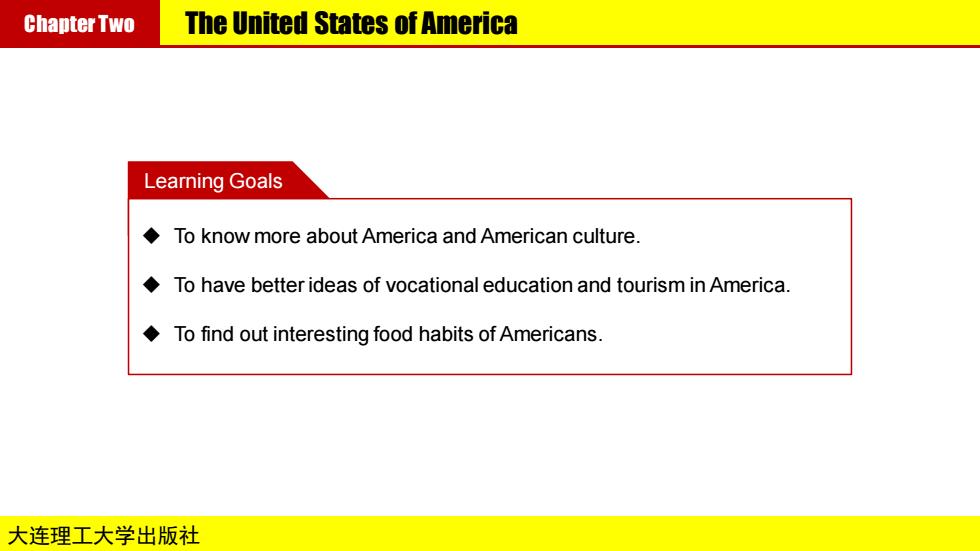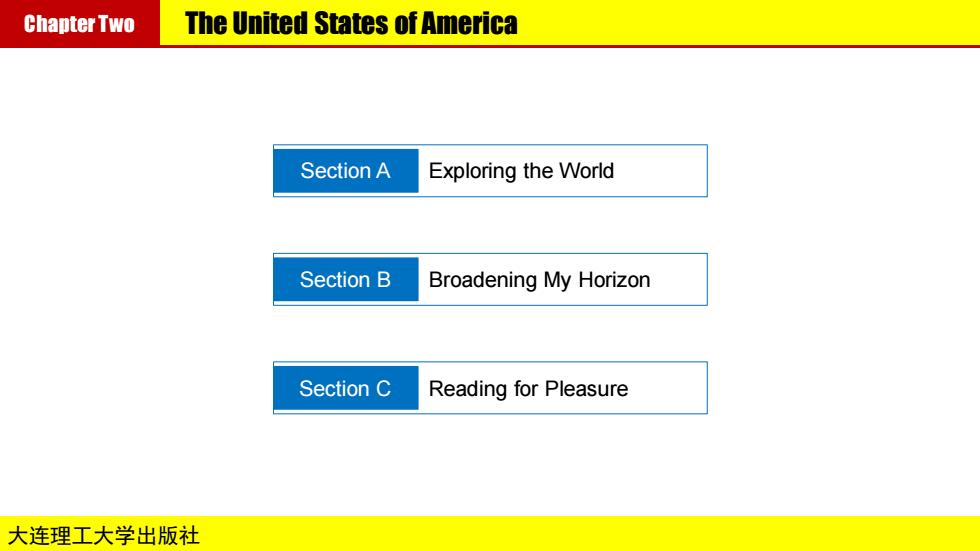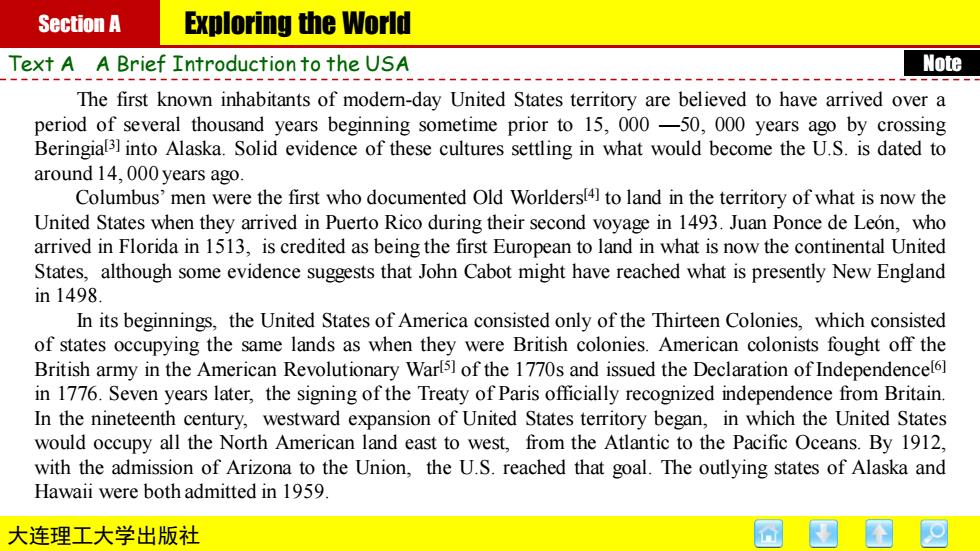
Chapter Two The United States of America Learning Goals To know more about America and American culture. ◆ To have better ideas of vocational education and tourism in America. To find out interesting food habits of Americans. 大连理工大学出版社
大连理工大学出版社 Chapter Two The United States of America Learning Goals ◆ To know more about America and American culture. ◆ To have better ideas of vocational education and tourism in America. ◆ To find out interesting food habits of Americans

Chapter Two The United States of America Section A Exploring the World Section B Broadening My Horizon Section C Reading for Pleasure 大连理工大学出版社
大连理工大学出版社 Chapter Two The United States of America Section A Exploring the World Section B Broadening My Horizon Section C Reading for Pleasure

Section A Exploring the World Leading In What do you know about the following pictures? 大连理工大学出版社 图①四
大连理工大学出版社 Section A Exploring the World Leading In What do you know about the following pictures?

Section A Exploring the World Text AA Brief Introduction to the USA Note The United States of America (commonly referred to as the United States,the U.S.,the USA,or America)is a federal constitutional republicl comprising fifty states and a federal district.The country is situated mostly in central North America,where its forty-eight contiguous states and Washington,D.C.,the capital district,lie between the Pacific and Atlantic Oceans,bordered by Canada to the north and Mexico to the south.The state of Alaska is in the northwest of the continent,with Canada to its east and Russia to the west across the Bering Strait.The state of Hawaii is an archipelago in the mid-Pacific.The country also possesses several territories,or insular areas,in the Caribbean and Pacific. The coastal plain of the Atlantic seaboard gives way further inland to deciduous forests and the rolling hills of the Piedmont.The Appalachian Mountainsl21 divide the eastern seaboard from the Great Lakes and the grasslands of the Midwest.The Mississippi-Missouri River,the world's fourth longest river system,runs mainly north-south through the heart of the country.The flat,fertile prairie of the Great Plains stretches to the west,interrupted by a highland region in the southeast.The Rocky Mountains,at the western edge of the Great Plains,extend north to south across the country,reaching an altitude of higher than 14,000 feet(4,300 m)in Colorado.Farther west is the rocky Great Basin and deserts such as the Mojave.Alaska's Mount McKinley is the country's tallest peak.Active volcanoes are common throughout Alaska's Alexander and Aleutian Islands,and Hawaii consists of volcanic islands.The super volcano underlying Yellowstone National Park in the Rockies is the continent's largest volcanic feature. 大连理工大学出版社
大连理工大学出版社 Section A Exploring the World Text A A Brief Introduction to the USA The United States of America (commonly referred to as the United States, the U.S., the USA, or America) is a federal constitutional republic[1] comprising fifty states and a federal district. The country is situated mostly in central North America, where its forty-eight contiguous states and Washington, D. C., the capital district, lie between the Pacific and Atlantic Oceans, bordered by Canada to the north and Mexico to the south. The state of Alaska is in the northwest of the continent, with Canada to its east and Russia to the west across the Bering Strait. The state of Hawaii is an archipelago in the mid-Pacific. The country also possesses several territories, or insular areas, in the Caribbean and Pacific. The coastal plain of the Atlantic seaboard gives way further inland to deciduous forests and the rolling hills of the Piedmont. The Appalachian Mountains[2] divide the eastern seaboard from the Great Lakes and the grasslands of the Midwest. The Mississippi-Missouri River, the world’s fourth longest river system, runs mainly north- south through the heart of the country. The flat, fertile prairie of the Great Plains stretches to the west, interrupted by a highland region in the southeast. The Rocky Mountains, at the western edge of the Great Plains, extend north to south across the country, reaching an altitude of higher than 14, 000 feet (4, 300 m) in Colorado. Farther west is the rocky Great Basin and deserts such as the Mojave. Alaska’s Mount McKinley is the country’s tallest peak. Active volcanoes are common throughout Alaska’s Alexander and Aleutian Islands, and Hawaii consists of volcanic islands. The super volcano underlying Yellowstone National Park in the Rockies is the continent’slargest volcanic feature. Note

Section A Exploring the World Text AA Brief Introduction to the USA Note The first known inhabitants of moder-day United States territory are believed to have arrived over a period of several thousand years beginning sometime prior to 15,000-50,000 years ago by crossing Beringial31 into Alaska.Solid evidence of these cultures settling in what would become the U.S.is dated to around 14,000 years ago. Columbus'men were the first who documented Old Worldersl4l to land in the territory of what is now the United States when they arrived in Puerto Rico during their second voyage in 1493.Juan Ponce de Leon,who arrived in Florida in 1513,is credited as being the first European to land in what is now the continental United States,although some evidence suggests that John Cabot might have reached what is presently New England in1498. In its beginnings,the United States of America consisted only of the Thirteen Colonies,which consisted of states occupying the same lands as when they were British colonies.American colonists fought off the British army in the American Revolutionary Warls1 of the 1770s and issued the Declaration of Independencel61 in 1776.Seven years later,the signing of the Treaty of Paris officially recognized independence from Britain. In the nineteenth century,westward expansion of United States territory began,in which the United States would occupy all the North American land east to west,from the Atlantic to the Pacific Oceans.By 1912, with the admission of Arizona to the Union,the U.S.reached that goal.The outlying states of Alaska and Hawaii were both admitted in 1959 大连理工大学出版社
大连理工大学出版社 Section A Exploring the World Text A A Brief Introduction to the USA The first known inhabitants of modern-day United States territory are believed to have arrived over a period of several thousand years beginning sometime prior to 15, 000 —50, 000 years ago by crossing Beringia[3] into Alaska. Solid evidence of these cultures settling in what would become the U.S. is dated to around 14, 000 years ago. Columbus’ men were the first who documented Old Worlders[4] to land in the territory of what is now the United States when they arrived in Puerto Rico during their second voyage in 1493. Juan Ponce de León, who arrived in Florida in 1513, is credited as being the first European to land in what is now the continental United States, although some evidence suggests that John Cabot might have reached what is presently New England in 1498. In its beginnings, the United States of America consisted only of the Thirteen Colonies, which consisted of states occupying the same lands as when they were British colonies. American colonists fought off the British army in the American Revolutionary War[5] of the 1770s and issued the Declaration of Independence[6] in 1776. Seven years later, the signing of the Treaty of Paris officially recognized independence from Britain. In the nineteenth century, westward expansion of United States territory began, in which the United States would occupy all the North American land east to west, from the Atlantic to the Pacific Oceans. By 1912, with the admission of Arizona to the Union, the U.S. reached that goal. The outlying states of Alaska and Hawaii were both admitted in 1959. Note